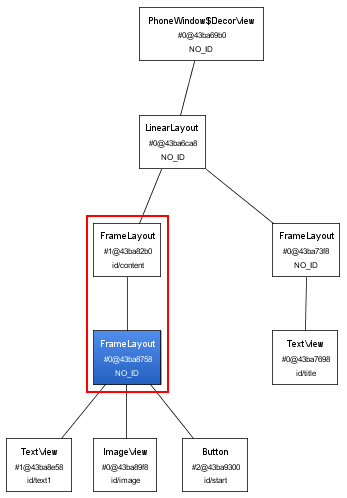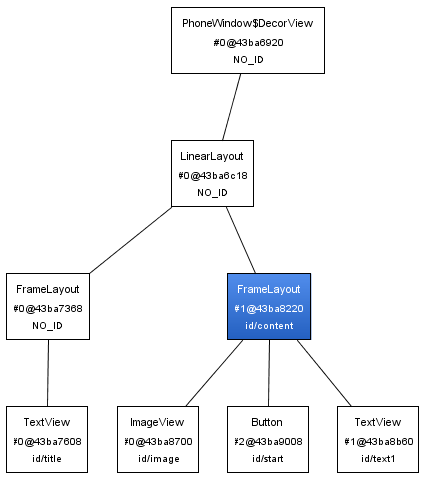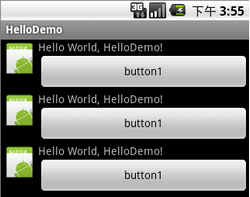Android UI学习 - FrameLayou和布局优化(viewstub)
FrameLayout
- <?xml version="1.0" encoding="utf-8"?>
- <FrameLayout
- xmlns:android="http://schemas.android.com/apk/res/android"
- android:layout_width="fill_parent"
- android:layout_height="fill_parent" >
- <ImageView
- android:id="@+id/image"
- android:layout_width="fill_parent"
- android:layout_height="fill_parent"
- android:scaleType="center"
- android:src="@drawable/candle"
- />
- <TextView
- android:id="@+id/text1"
- android:layout_width="wrap_content"
- android:layout_height="wrap_content"
- android:layout_gravity="center"
- android:textColor="#00ff00"
- android:text="@string/hello"
- />
- <Button
- android:id="@+id/start"
- android:layout_width="wrap_content"
- android:layout_height="wrap_content"
- android:layout_gravity="bottom"
- android:text="Start"
- />
- </FrameLayout>



布局优化
- <?xml version="1.0" encoding="utf-8"?>
- <merge xmlns:android="http://schemas.android.com/apk/res/android">
- <ImageView
- android:id="@+id/image"
- android:layout_width="fill_parent"
- android:layout_height="fill_parent"
- android:scaleType="center"
- android:src="@drawable/candle"
- />
- <TextView
- android:id="@+id/text1"
- android:layout_width="wrap_content"
- android:layout_height="wrap_content"
- android:layout_gravity="center"
- android:textColor="#00ff00"
- android:text="@string/hello"
- />
- <Button
- android:id="@+id/start"
- android:layout_width="wrap_content"
- android:layout_height="wrap_content"
- android:layout_gravity="bottom"
- android:text="Start"
- />
- </merge>
- <?xml version="1.0" encoding="utf-8"?>
- <LinearLayout xmlns:android="http://schemas.android.com/apk/res/android"
- android:orientation="vertical"
- android:layout_width="fill_parent"
- android:layout_height="fill_parent">
- <include android:id="@+id/layout1" layout="@layout/relative" />
- <include android:id="@+id/layout2" layout="@layout/relative" />
- <include android:id="@+id/layout3" layout="@layout/relative" />
- </LinearLayout>

- <ViewStub android:id="@+id/stub"
- android:inflatedId="@+id/subTree"
- android:layout="@layout/mySubTree"
- android:layout_width="120dip"
- android:layout_height="40dip" />
- ViewStub stub = (ViewStub) findViewById(R.id.stub);
- View inflated = stub.inflate();
本文出自 “学习Android” 博客,请务必保留此出处http://android.blog.51cto.com/268543/308090
Android UI学习 - FrameLayou和布局优化(viewstub)的更多相关文章
- Android UI 学习 自定义的布局 平滑移动 VelocityTracker()
/** * Helper for tracking the velocity of touch events, for implementing * flinging and other such ...
- Android 性能优化 三 布局优化ViewStub标签的使用
小黑与小白的故事,通过虚拟这两个人物进行一问一答的形式来共同学习ViewStub的使用 小白:Hi,小黑,ViewStub是什么?听说能够用来进行布局优化. 小黑:ViewStub 是一个隐藏的,不占 ...
- Android实习生 —— 屏幕适配及布局优化
为什么要进行屏幕适配.对哪些设备进行适配?在近几年的发展当中,安卓设备数量逐渐增长,由于安卓设备的开放性,导致安卓设备的屏幕尺寸大小碎片化极为严重.从[友盟+]2016年手机生态发展报告H1中看截止1 ...
- Android UI基础之五大布局
Android UI基础之五大布局 Android的界面是有布局和组件协同完成的,布局好比是建筑里的框架,而组件则相当于建筑里的砖瓦.组件按照布局的要求依次排列,就组成了用户所看见的界面.Andro ...
- Android UI学习 - ListView (android.R.layout.simple_list_item_1是个什么东西)
Android UI学习 - ListView -- :: 标签:Android UI 移动开发 ListView ListActivity 原创作品,允许转载,转载时请务必以超链接形式标明文章 原始 ...
- Android开发学习之路--性能优化之布局优化
Android性能优化方面也有很多文章了,这里就做一个总结,从原理到方法,工具等做一个简单的了解,从而可以慢慢地改变编码风格,从而提高性能. 一.Android系统是如何处理UI组件的更新操作的 ...
- android菜鸟学习笔记6----android布局(一)
Android应用的UI组件都是继承自View类,View类表示的就是一个空白的矩形区域.常用的组件如TextView.Button.EditText等都直接或间接继承自View. 此外,View还有 ...
- Android UI学习前言:Android UI系统的知识结构
Android UI系统的知识结构如下图所示: 对于 一个GUI系统地使用,首先是由应用程序来控制屏幕上元素的外观和行为,这在各个GUI系统中是不相同的,但是也具有相通性.Android系统在这方面, ...
- Android UI学习组件概述
Android的UI组件繁多,如果学习的时候不能自己总结和分类而是学一个记一个不去思考和学习他们内在的联系那真的是只有做Farmer的命了.为了向注定成为Farmer的命运抗争,在学习Android的 ...
随机推荐
- MITK Tutorial(二)
目标: 生成MITK 插件包括一个新用户交互的视图,并调用一些ITK filters. Step 1: How to create a new MITK Plugin 可以选择用Plugin Gene ...
- 百度地图API使用
1.引用js脚本 <script type="text/javascript" src="http://api.map.baidu.com/api?v=2.0&am ...
- C# book
<编写高质量代码:改善C#程序的157个建议>源码下载 http://www.cnblogs.com/luminji/archive/2011/09/20/2182265.html < ...
- 【POJ】【2151】Check the difficulty of problems
概率DP kuangbin总结中的第8题 一开始题目看错导致想转移方程想错了……想成f[i][j]表示前 i 个队伍中最多的做出来 j 道题的概率……sigh 看了下题解……其实是对于每个队伍 i 单 ...
- WSDL 文档解析
学习webservice,就离不了WSDL文档,他是我们开发WebService的基础,虽说,现在现在有许多WebService的开源框架使得我们可以根据WSDL生成客户端代码,但是,了解WSDL文档 ...
- 项目中的Libevent(多线程)
多线程版Libevent //保存线程的结构体 struct LibeventThread { LibEvtServer* that; //用作传参 std::shared_ptr<std::t ...
- iOS开发之深入探讨runtime机制01-类与对象
最近有个同事问我关于“runtime机制”的问题,我想可能很多人对这个都不是太清楚,在这里,和大家分享一下我对于runtime机制的理解.要深入理解runtime,首先要从最基本的类与对象开始,本文将 ...
- ios开发之网络访问的数据类型
1> JSON 特点:1. [ ] 表示数组 {} 表示字典 - 对象模型建立关系 2. 应用非常多,基本上移动开发的主要数据传输都是JSON 要使用JSON,从网络上获取到数据data后,直 ...
- PHP的反射机制(转)
介绍: PHP5添加了一项新的功能:Reflection.这个功能使得phper可以reverse-engineer class, interface,function,method and exte ...
- spoj 147
dfs枚举真值 #include <cstdio> #include <cstring> #include <cstdlib> #include <stack ...
